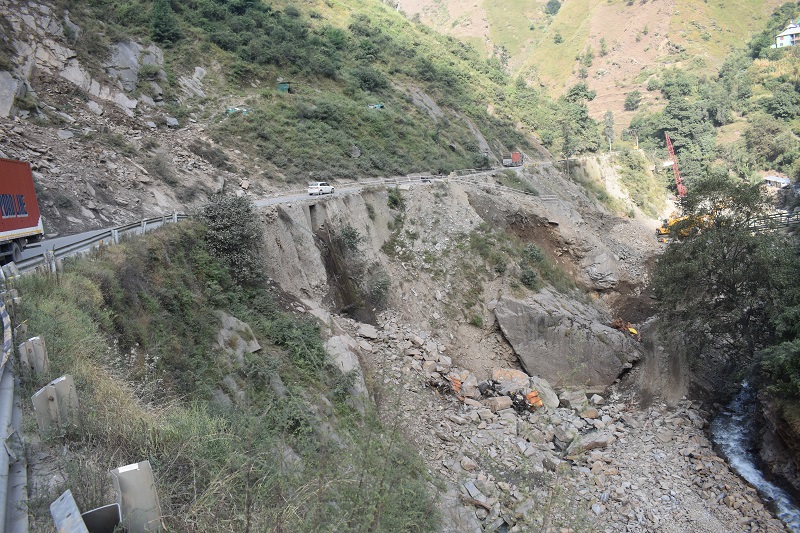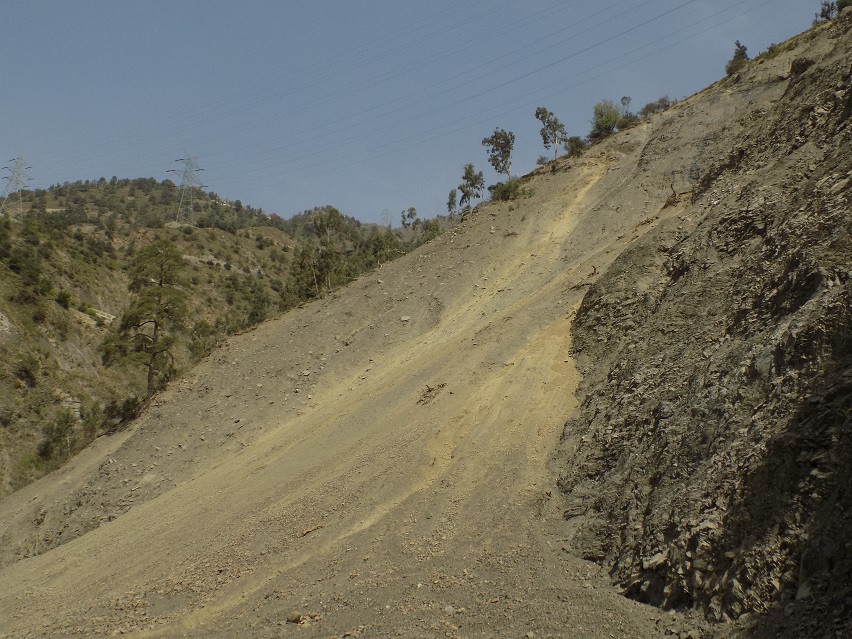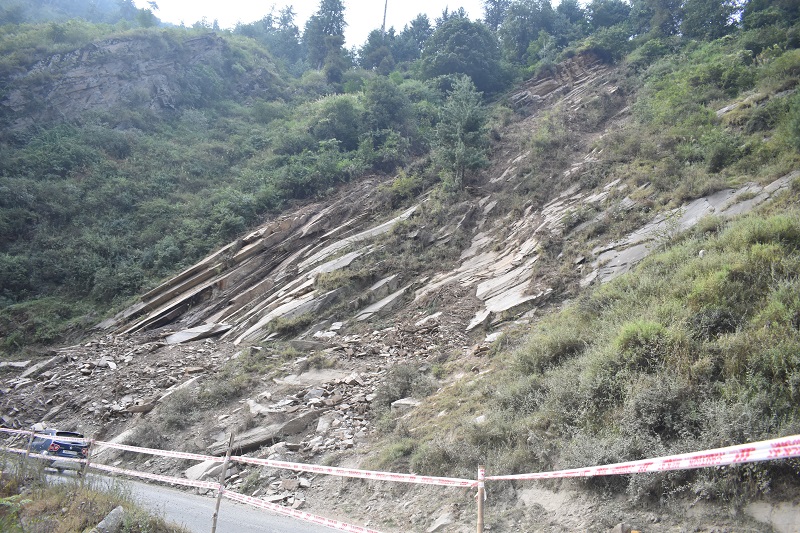
Srinagar- In the shadow of towering peaks and ever-shifting terrain, the Srinagar-Jammu National Highway also known as NH-44, remains an unyielding enigma. Despite years of roadworks and tunnel constructions, the fear of travelling through this lifeline stays.
On September 12, a tragedy struck when a landslide hit a vehicle and claimed four lives. Is there an escape from this deadly embrace? What forces drive these mountains to slip? To discover the answers, Kashmir Observer delved deep into the science and solutions with experts.
Geological Factors leading to Frequent Landslides
Experts at the Geological Survey of India, which being the nodal agency for landslide studies in India, told Kashmir Observer that the landslides are caused by the gravitational pull of unstable earth material down the slope.

They mention five to six causative or pre-disposing factors and few triggering reasons for causing a landslide. These factors include the nature and strength of geological materials, the structure of joints and faults (Joints are cracks or fracture present in the rocks along which there has been no displacement), hydrological conditions, Land use and land cover, slope form, and the angle of steepness.
To elaborate further, the Himalayan Mountain system are produced and elevated by the tectonic forces. These forces also lead to the development of numerous fractures and cracks in the rocks, which is the primary reason rocks slide down under gravity in different areas. In flat landscapes, the risk of landslides is lower, whereas it increases in elevated areas.

“The second factor is the nature of rocks found in a particular area. Additionally, shallow underground water conditions can also contribute in landslides. Other factors include slope parameters, which are not directly geological but can be surface morphometric. For example, steeper slopes are more prone to slides, while gentler slopes have a lower risk. The absence of trees and deforestation can also increase the landslide hazards. However, in rocky slopes roots by dense forests can also widen the joints, thereby increase the chances of landslides,” a senior scientist at GSI said, wishing not to be named.
On being asked, if the construction of four-lane projects on NH44 is triggering frequent landslides, he said that this is partly true and partly false.

“The primary triggering factors are hydrological in the form of rainfall & snowmelt, but more than 50 percent of landslides are also caused by anthropogenic activities triggered by cut slope during road construction. For instance, in the stretch from NH44 to Mughal Road, construction companies have largely neglected and delayed the safety measures like rock bolting, wire meshing, and benching to prevent rocks from sliding down. Similarly, on NH44, despite safety measures, construction agencies sometimes prioritize speeding up of the project over compliance with standard operating procedures. This increases the risk of landslides, affecting traffic and can lead to human losses,” he said.
The scientist further detailed out that since 2017, the frequency of landslides has increased significantly. In the Batote area, for example, a different anthropogenic activity has been reported – the unplanned expansion of urban areas over pre-historic landslides. “Most urban waste and runoff flow toward the eastern slope of the Batote township area, resulting in large landslides and extensive development of cracks in hundreds of houses located there. This situation is linked to excessive and unplanned urban expansion along with developmental projects on geologically unstable slopes at the expense of landslide prevention.”
Assistant Professor, Department of Geoinformatics, University of Kashmir, Dr Irfan Rashid explained that NH44 passes through mountainous terrain characterized by steep slopes.
These slopes often feature a weathered and fractured lithology indicating that the rock types have deteriorated over time. When excavation takes place for the purpose of expanding the highway, whether for four lanes or two lanes, it inevitably leads to significant mass wastage in the form of landslides and rockfalls. This has been a recurring issue for many years, he said.
“In the case of four-laning of NH44, cutting slopes at certain locations proves to be unfeasible due to the steep terrain and the highly fractured nature of the rocks. Consequently, excavation on the lower side of these areas can trigger the upstream section to disintegrate into fragments. The stretch from Ramban to Ramsu is particularly susceptible to landslides. To prevent such incidents, a more scientifically informed approach to mountain excavation is imperative, especially in these geologically fragile mountains,” he maintained.
Rashid elaborated that the excavation of steep slopes renders them unstable, especially during periods of rainfall or snowfall. These fractured rocks tend to absorb moisture through the cracks, which diminishes the frictional forces. “As a result, numerous landslides, road closures, rockfalls, and mass wastages predominantly occur during the winter months. During winter, snowmelt and rainfall infiltrate these spaces, exacerbating the instability of rock formations and soil,” he said.
Dr Irfan said the climate change can also contribute to increase in landslides. Extreme and irregular precipitation events can result snow avalanches. Similarly untimely rainfall can offer lubrication to these vulnerable landscapes. “Consequently, the incidence of landslides is expected to increase proportionally as these precipitation-based weather events become more frequent,” he said.

A latest study titled “Extreme precipitation events and landslide activity in the Kashmir Himalaya” evaluated the landslide history from 1990 to 2020 in Kashmir Himalaya and how it relates to heavy rainfall. They used different measures to understand how heavy rainfall triggers landslides. The research conducted by University of Kashmir was published in July 2023 in Bulletin of Engineering Geology and the Environment volume.
The study found that there’s a strong connection between heavy rainfall and landslides, especially along NH-44. “As the climate changes, extreme weather events may increase, leading to more landslides in the future,” the findings revealed.
What is the way forward?
The 270 km long arterial National Highway (NH 1A) which was renumbered as NH 44 in 2010 connects Kashmir valley to the rest of India.
Panthyal, Ramsoo, Anokhifal, Nashri, Maroog, Battery Cheshma, Kheri along the Bichleri stream in Ramban district and Udhampur district are the landslide prone areas along the highway. Bichleri joins Chenab downstream Ramban.
Assistant Professor, Department of Geoinformatics, University of Kashmir, Dr Irfan Rashid said to address these challenges effectively, there is a pressing need to establish an operational prediction mechanism capable of forecasting the areas at risk of landslides or heavy rainfall.
“It is recommended that the National Highways Authority of India (NHAI) collaborate with the Geological Survey of India (GSI) and the Indian Space Research Organisation (ISRO). Satellite data, particularly for high-resolution topographical mapping, could be harnessed in partnership with ISRO. This collaborative effort should also involve academic experts from the Universities to identify vulnerable areas accurately,” he said.
Excerpts from the landslide Susceptibility reports of GSI pointed out certain things that need to be taken in consideration when constructing roads in any area. “Mountain slopes are made up of two types of earth materials: soil and rock. Different safety measures are required for each. In the Himalayas, where landslides are common, it’s crucial to consider the highly crushed and fractured rocks. We must assess the strength of these rocks and the probability of sliding, predicting future slides. The Geological Survey of India has prepared susceptibility maps along different road stretches in UT: J&K including the NH44 and Mughal Road, which if implemented will considerably help in mitigating the landslides,” the reports mentioned.
The reports stressed that the safety measures taken by the implementing agencies should include rock bolting for large slabs prone to sliding, and for highly crushed material, using concrete and wire mesh for support. For soil, local plantation material can be the best technique.
“In the developed countries, Bio-and Eco-engineering-based willow tree root reinforcement is one of the measures used in soil and debris covered road projects, and the willows being native to Kashmir should be propagated and implemented here to control debris and earth slides and promote natural vegetation. Proper drainage treatment is also crucial to manage urban runoff, preventing water, whether from snowmelt, rainfall, or urban runoff, from triggering landslides in soil materials. In rock areas, addressing steep cutting is essential,” scientists at the Geological Survey of India said.
The experts added, afforestation efforts exist in some random places, but they should be based on scientific inputs and coordinated between different departments. The GSI, being the nodal agency for landslides should be involved in town planning and road planning in landslide prone areas, similar to practices in the developed countries, to bridge this gap.
Response of National Highway Authority of India (NHAI)
Shubam Yadav, Technical Manager National Highway Authority of India (NHAI) told Kashmir Observer that they have resorted to tunnel construction and installing wire ducts to mitigate the recurring landslide challenges in high-risk areas on the highway. These landslide-prone zones include Panthal, Ramban, Digdol, and Khooni Nallah etc.
Yadav said due to the geological fragility of this region, inherent risks persist, but we are implementing all the necessary safety measures. “Travelers should adhere to specified speed limits for their safety. Many a times, crossing the speed limits causes road fatalities.”
Furthermore, he said, that they are in the process of installing a real-time monitoring system within the tunnels to enhance safety and surveillance capabilities. “These smart tunnel monitoring systems are widely used in road tunnels. These systems are capable of monitoring various physical parameters such as the amount of strain or deformation, stress, load, pressure, pore water pressure, size of any cracks, and deformation of the rock mass. The real-time data collection and analysis can help in optimizing the tunnel’s operation, and improving safety,” Yadav said.
Follow this link to join our WhatsApp group: Join Now
Be Part of Quality Journalism |
Quality journalism takes a lot of time, money and hard work to produce and despite all the hardships we still do it. Our reporters and editors are working overtime in Kashmir and beyond to cover what you care about, break big stories, and expose injustices that can change lives. Today more people are reading Kashmir Observer than ever, but only a handful are paying while advertising revenues are falling fast. |
| ACT NOW |
| MONTHLY | Rs 100 | |
| YEARLY | Rs 1000 | |
| LIFETIME | Rs 10000 | |










